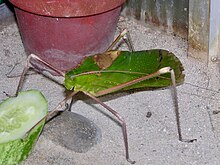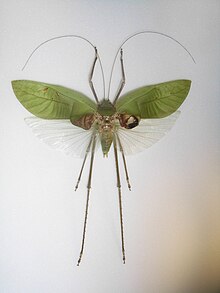| Arachnacris corporalis | |
|---|---|

| |

| |
| At Kuala Lumpur Butterfly Park (above); specimen with spread wings (below) | |
| Scientific classification | |
| Domain: | Eukaryota |
| Kingdom: | Animalia |
| Phylum: | Arthropoda |
| Class: | Insecta |
| Order: | Orthoptera |
| Suborder: | Ensifera |
| Family: | Tettigoniidae |
| Genus: | Arachnacris |
| Species: | A. corporalis |
| Binomial name | |
| Arachnacris corporalis (Karny, 1924) | |
| Synonyms | |
| |
Arachnacris corporalis, the giant Malaysian katydid, giant long-legged katydid or giant katydid (not to be confused with Stilpnochlora couloniana, a species native to the United States), is a large species of bush cricket or katydid that is native to Malaysia. It is the largest species of katydid in the world.
Description
The giant Malaysian katydid is a large green insect that is, on average, about 6 inches long. They have long, thin legs, like most katydids, with the hind legs being longer than the front two pairs of legs. They have long, leaf-like wings that help them stay camouflaged from predators, as they typically reside in trees and don't move very much. As they age, their coloration mimics a leaf, and the tips of their wings become brown to resemble the way that leaves rot. The amount of brown on their wings can be used as a method to determine the age of the katydid, with more brown meaning an older age.
Like all katydids, they make a loud chirping sound by scraping a toothed stridulatory file found near the base of one wing against a scraper located on the opposite wing. They use this sound as a defense mechanism and to attract mates.
Sexual dimorphism
Adult males and females of the species are easily distinguished, as females have a green pronotum and males have a brown pronotum, which is the triangular segment at the dorsal base of their wings.
Life cycle and reproduction
Females have an ovipositor, which they use to lay their eggs in moss or rotting wood. When they reach their adult stage, they start out bright green and, as they get older, the tips of their wings turn brown, leading to a larger brown patch the older the katydid is. They live for about 6 months in their adult stage.
Predator defense
Their primary defense is camouflage due to their leaf-like coloration. To prevent being tracked down by scent, they throw their feces as far away from them as possible, usually to a neighboring bush or tree. They can also use their loud chirping to scare away predators, as the volume is amplified due to their size.
References
- (in German) Karny (1924) Beiträge zur Malayischen Orthopterenfauna IV-XI, Treubia 5(1-3):1-234, Pl. I, II
- "Giant Malaysian Katydid". Audubon Nature Institute.
- "The World's Weirdest Bugs". DUKE TIP NAVIGATOR. November 14, 2016.
- ^ ShawTVSSM (Sep 8, 2015). "Entomica - BugOut - The Giant Malaysian Katydid". YouTube.
- Lewis, Riccie (Apr 17, 2022). "🇲🇾 Malaysian Giant Katydid, the largest species in the world". YouTube.
| Taxon identifiers | |
|---|---|
| Arachnacris corporalis | |
This article about a member of the insect family Tettigoniidae is a stub. You can help Misplaced Pages by expanding it. |